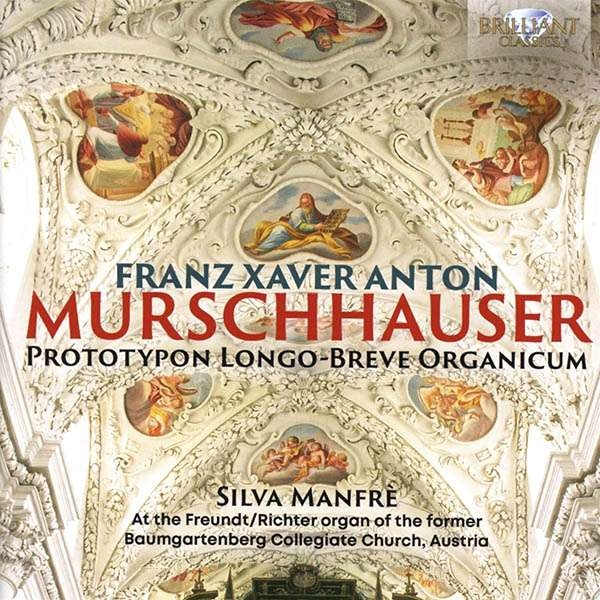Košík
Váš košík je momentálne prázdny.
Murschhauser: Prototypon Longo-Breve Organicum
12,00 €
Formát:
CD
Dostupnosť:
7-14 dní
Katalógové číslo:
96707
EAN kód:
5028421967073
Autori:
Franz Xaver Murschhauser
Interpreti:
Silva Manfrè
Vydavateľ:
BRILLIANT CLASSICS
Zoznam skladieb
Prototypon longo-breve organicum, IFM 6, pars prima1 I. Intonatio primi toni
2 II. Praeambulum primi toni
3 III. Fuga prima primi toni
4 IV. Fuga secunda primi toni
5 V. Fuga finalis primi toni
6 VI. Praeambulum primi toni
7 VII. Praeambulum secundi toni
8 VIII. Fuga secundi toni
9 IX. Praeambulum aliud secundi toni
10 X. Fuga alia secundi toni
11 XI. Fuga secundi toni
12 XII. Arpeggiata overo toccata secundi toni
13 XIII. Praeambulum tertii toni
14 XIV. Fuga tertii toni
15 XV. Fuga brevissima tertii toni
16 XVI. Praeambulum tertii toni
17 XVII. Praeambulum brevissimum tertii toni
18 XVIII. Fuga tertii toni
19 XIX. Finale septimi toni
20 XX. Fuga prima septimi toni
21 XXI. Praeambulum septimi toni
22 XXII. Fuga secunda septimi toni
Prototypon longo-breve organicum, IFM 6, pars secunda
23 I. Intonatio octavi toni cum, pedali ad libitum
24 II. Praeambulum octavi toni
25 III. Fuga prima octavi toni
26 IV. Fuga secunda octavi toni
27 V. Toccata arpeggiata octavi toni
28 VI. Praeambulum decimi toni
29 VII. Fuga decimi toni
30 VIII. Praeambulum decimi toni cum pedali ad libitum
31 IX. Fuga decimi toni
32 X. Finale decimi toni cum pedali ad libitum
33 XI. Toccata undecimi toni pro pedali
34 XII. Fuga brevis undecimi toni
35 XIII. Fuga sive canzon prima undecimi toni
36 XIV. Fuga sive canzon secunda undecimi toni
37 XV. Praeambulum undecimi toni
38 XVI. Toccata arpeggiata brevis undecimi toni
39 XVII. Praeambulum duodecimi toni
40 XVIII. Fuga prima duodecimi toni
41 XIX. Fuga secunda duodecimi toni
42 XX. Fuga tertia duodecimi toni
43 XXI. Fuga quarta duodecimi toni
44 XXII. Toccata duodecimi toni cum pedali ad libitum
45 XXIII. Toccata duodecimi toni
46 XXIV. Toccata duodecimi toni
Popis
Franz Xaver Murschhauser was born in the summer of 1663. In 1676 Murschhauser joined the choir and orchestra of St Peter’s, where he benefited first from the tuition he received from the church’s choir director Sigmund Auer and later, from 1684 to 1693, from the Court Kapellmeister Johann Kaspar Kerll, which left a lasting impression on him. In July 1690, most probably on the recommendation of his teacher Johann Kaspar Kerll, Murschhauser was asked to stand in for the choirmaster of the Munich Frauenkirche, Ludwig Hölz, who was indisposed owing to illness. After the latter’s death in 1691, Murschhauser became his successor, holding the position for the remainder of his life. The Prototypon Longo-Breve Organicum (which might be translated as ‘Prototypes for organ pieces, long and short’) was published in two parts in Nuremberg in 1703 and 1707 and contains eight cycles/sections totalling 46compositions, comprising varying numbers of intonations, praeambulae, fugues, canzonas, toccatas and finales designed as preludes or postludes to figural music. In 20 of the more extensive numbers, Murschhauser indicates cuts as an aid for organists in liturgical use, if needed. It is precisely these sorts of adaptations of the musical material offered by the composer himself to suit the time available in liturgical performance that make the Prototypon such a practical and relevant work, right down to our own times. The intonations are made up of figures, broken chords and passages over a pedal point, deliberately kept free of any imitative interplay. The praeambulae consist either of motivic figurations with imitative passages and pedal points somewhat reminiscent of the style of Johann Pachelbel, or they are more akin to the old Italian toccata in their alternation of chord successions and scales. By contrast, the two toccate arpeggiate, with their full-voiced chordal writing and harmonic richness, point to the Overture in the French style which, at this time, was finding its way into southern German music primarily through the work of Johann Kaspar Ferdinand Fischer. In his edition of the Prototypon (housed in Vol. 18 of Monuments of Musical Art in Bavaria), Max Seiffert writes: ‘In all these pieces, Murschhauser demonstrates a remarkable creative power and contrapuntal skill’. In this respect, the Prototypon Longo-Breve Organicum by Franz Xaver Anton Murschhauser remains an important record of musical and organ performance in the southern German Early Baroque, and one that can still offer a valuable service to the organists of today. The German baroque composer Franz Xaver Anton Murschhauser (1663–1738), was Kapellmeister at the Frauenkirche (today the cathedral) in Munich and was a student of Johann Caspar Kerll. He wrote several collections of organ music, among which his most important „Prototypon Longo-Breve Organicum“, written between 1703 and 1707. This two-part collection contains eight cycles of Intonations, Toccatas, Preludes, Canzoni and Finales in the eight most commonly used church modes. There are a total of 46 (mostly short) pieces that represent a very interesting and impressive document of southern German organ practice – roughly comparable to Johann Caspar Kerll's Modulatio Organica – the structure of which is still very useful for organists today. Compared to his earlier organ works the Prototypon features more extended and freely concertante pieces, and the technique here has also become more complex in the use of often daring contrapuntal stylistic devices. The intonations are composed of playing figures, broken chords or passages over an organ point, deliberately kept free of any imitative interplay. Played on the historic 1662 Freundt/Richter Organ of the Stiftskirche Baumgartenberg, the specifications of which are included in the booklet. Silva Manfrè studied organ and organ composition at the Conservatory of Music in Verona (Italy), at the University of Music and Performing Arts of Vienna (Austria) and Musicology at the Universities of Pavia and Vienna. Among her main interests are lesser known or rarely performed compositions of the Renaissance and the Baroque. Her previous recording of organ works by Ottavio Bariolla (96376) was enthusiastically received. Prihlásenie
Newsletter



